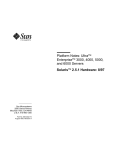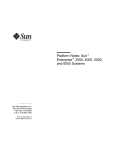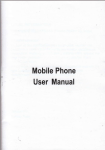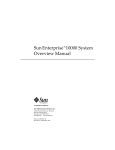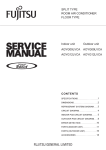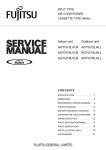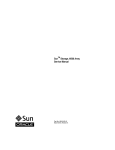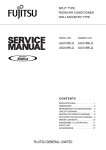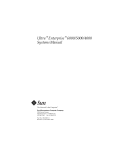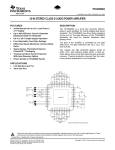Download 1 - Oracle Documentation
Transcript
Platform Notes: Ultra™ Enterprise™
3000, 4000, 5000, and 6000 Systems
Sun Microsystems Computer Company
2550 Garcia Avenue
Mountain View, CA 94043 USA
415 960-1300
fax 415 969-9131
Part No.: 802-6634-10
Revision A, May 1996
1995 Sun Microsystems, Inc. 2550 Garcia Avenue, Mountain View, California 94043-1100 U.S.A.
All rights reserved. This product or document is protected by copyright and distributed under licenses restricting its use,
copying, distribution, and decompilation. No part of this product or document may be reproduced in any form by any means
without prior written authorization of Sun and its licensors, if any.
Portions of this product may be derived from the UNIX® system, licensed from UNIX System Laboratories, Inc., a wholly owned
subsidiary of Novell, Inc., and from the Berkeley 4.3 BSD system, licensed from the University of California. Third-party
software, including font technology in this product, is protected by copyright and licensed from Sun’s suppliers.
RESTRICTED RIGHTS LEGEND: Use, duplication, or disclosure by the government is subject to restrictions as set forth in
subparagraph (c)(1)(ii) of the Rights in Technical Data and Computer Software clause at DFARS 252.227-7013 and FAR 52.227-19.
The product described in this manual may be protected by one or more U.S. patents, foreign patents, or pending applications.
TRADEMARKS
Sun, Sun Microsystems, the Sun logo, SunSoft, the SunSoft logo, Solaris, SunOS, OpenWindows, DeskSet, ONC, ONC+, and NFS
are trademarks or registered trademarks of Sun Microsystems, Inc. in the United States and other countries. UNIX is a registered
trademark in the United States and other countries, exclusively licensed through X/Open Company, Ltd. OPEN LOOK is a
registered trademark of Novell, Inc. PostScript and Display PostScript are trademarks of Adobe Systems, Inc.
All SPARC trademarks are trademarks or registered trademarks of SPARC International, Inc. in the United States and other
countries. SPARCcenter, SPARCcluster, SPARCompiler, SPARCdesign, SPARC811, SPARCengine, SPARCprinter, SPARCserver,
SPARCstation,SPARCstation Voyager, SPARCstorage, SPARCworks, microSPARC, microSPARC-II, and UltraSPARC are
licensed exclusively to Sun Microsystems, Inc. Products bearing SPARC trademarks are based upon an architecture developed by
Sun Microsystems, Inc.
The OPEN LOOK® and Sun™ Graphical User Interfaces were developed by Sun Microsystems, Inc. for its users and licensees.
Sun acknowledges the pioneering efforts of Xerox in researching and developing the concept of visual or graphical user
interfaces for the computer industry. Sun holds a non-exclusive license from Xerox to the Xerox Graphical User Interface, which
license also covers Sun’s licensees who implement OPEN LOOK GUIs and otherwise comply with Sun’s written license
agreements.
X Window System is a trademark of X Consortium, Inc.
THIS PUBLICATION IS PROVIDED “AS IS” WITHOUT WARRANTY OF ANY KIND, EITHER EXPRESS OR IMPLIED,
INCLUDING, BUT NOT LIMITED TO, THE IMPLIED WARRANTIES OF MERCHANTABILITY, FITNESS FOR A
PARTICULAR PURPOSE, OR NON-INFRINGEMENT.
THIS PUBLICATION COULD INCLUDE TECHNICAL INACCURACIES OR TYPOGRAPHICAL ERRORS. CHANGES ARE
PERIODICALLY ADDED TO THE INFORMATION HEREIN. THESE CHANGES WILL BE INCORPORATED IN NEW
EDITIONS OF THE PUBLICATION. SUN MICROSYSTEMS, INC. MAY MAKE IMPROVEMENTS AND/OR CHANGES IN
THE PRODUCT(S) AND/OR THE PROGRAMS(S) DESCRIBED IN THIS PUBLICATION AT ANY TIME.
Please
Recycle
Copyright 1995 Sun Microsystems, Inc., 2550 Garcia Avenue, Mountain View, Californie 94043-1100 U.S.A.
Tous droits réservés. Ce produit ou document est protégé par un copyright et distribué avec des licences qui en restreignent
l’utilisation, la copie et la décompilation. Aucune partie de ce produit ou de sa documentation associée ne peut être reproduits
sous aucune forme, par quelque moyen que ce soit sans l’autorisation préalable et écrite de Sun et de ses bailleurs de licence, s’il y
en a.
Des parties de ce produit pourront être derivées du système UNIX® et du système Berkeley 4.3 BSD licencié par l’Université de
Californie. UNIX est une marque enregistrée aux Etats-Unis et dans d’autres pays, et licenciée exclusivement par X/Open
Company Ltd. Le logiciel détenu par des tiers, et qui comprend la technologie relative aux polices de caractères, est protégé par
un copyright et licencié par des fournisseurs de Sun.
Sun, Sun Microsystems, le logo Sun, et Solaris sont des marques déposées ou enregistrées par Sun Microsystems, Inc. aux EtatsUnis et dans certains d’autres pays. Toutes les marques SPARC, utilisées sous license, sont des marques déposées ou enregistrées
de SPARC International, Inc. aux Etats-Unis et dans d’autres pays. Les produits portant les marques SPARC sont basés sur une
architecture développée par Sun Microsystems, Inc.
Les utilisateurs d’interfaces graphiques OPEN LOOK® et Sun™ ont été développés par Sun Microsystems, Inc. pour ses
utilisateurs et licenciés. Sun reconnaît les efforts de pionniers de Xerox pour la recherche et le développement du concept des
interfaces d’utilisation visuelle ou graphique pour l’industrie de l’informatique. Sun détient une licence non exclusive de Xerox
sur l’interface d’utilisation graphique, cette licence couvrant aussi les licenciés de Sun qui mettent en place OPEN LOOK GUIs et
qui en outre se conforment aux licences écrites de Sun.
Le système X Window est un produit du X Consortium, Inc.
CETTE PUBLICATION EST FOURNIE "EN L’ETAT" SANS GARANTIE D’AUCUNE SORTE, NI EXPRESSE NI IMPLICITE, Y
COMPRIS, ET SANS QUE CETTE LISTE NE SOIT LIMITATIVE, DES GARANTIES CONCERNANT LA VALEUR
MARCHANDE, L’APTITUDE DES PRODUITS A REPONDRE A UNE UTILISATION PARTICULIERE OU LE FAIT QU’ILS NE
SOIENT PAS CONTREFAISANTS DE PRODUITS DE TIERS.
Contents
1. OpenBoot™ 3.x Commands . . . . . . . . . . . . . . . . . . . . . . . . . . . .
1
Environmental Monitoring . . . . . . . . . . . . . . . . . . . . . . . . . . . . . .
1
Messages Indicating Environmental Conditions . . . . . . . . .
1
Externally Initiated Reset XIR . . . . . . . . . . . . . . . . . . . . . . . . . . .
2
Flash PROM Management . . . . . . . . . . . . . . . . . . . . . . . . . . . . . .
3
POST Status Display . . . . . . . . . . . . . . . . . . . . . . . . . . . . . . . . . . .
4
TODC Management. . . . . . . . . . . . . . . . . . . . . . . . . . . . . . . . . . . .
7
Ultra Enterprise 3000-, 4000-, 5000-, 6000-Specific NVRAM
Variables . . . . . . . . . . . . . . . . . . . . . . . . . . . . . . . . . . . . . . . . . .
8
2. Board Hot Plug Software Procedures . . . . . . . . . . . . . . . . . . . .
13
Disabled System Board . . . . . . . . . . . . . . . . . . . . . . . . . . . . . . . . .
13
Activated System Board . . . . . . . . . . . . . . . . . . . . . . . . . . . . . . . .
13
Swapping A Disabled Board . . . . . . . . . . . . . . . . . . . . . . . . . . . .
14
Swapping An Activated Board. . . . . . . . . . . . . . . . . . . . . . . . . . .
14
Disabling Hardware . . . . . . . . . . . . . . . . . . . . . . . . . . . . . . . . . . .
14
Disabling Component, Board, System . . . . . . . . . . . . . . . . .
14
v
vi
Requesting Board Disable. . . . . . . . . . . . . . . . . . . . . . . . . . . .
15
3. Brief Miscellaneous Notes . . . . . . . . . . . . . . . . . . . . . . . . . . . . .
17
Hardware Watchdog . . . . . . . . . . . . . . . . . . . . . . . . . . . . . . . . . . .
17
History Log Option of prtdiag(1M) . . . . . . . . . . . . . . . . . . . . .
17
Platform Notes:Ultra Enterprise 3000,4000,5000,and 6000 Systems—May 1996
OpenBoot™ 3.x Commands
1
This chapter includes information about Solaris™ 2.5.1 OpenBoot 3.x
commands for the Ultra Enterprise 3000, 4000, 5000, and 6000.
Environmental Monitoring
disable-environmental-monitor
Usage: disable-environmental-monitor ( -- )
Purpose: To stop monitoring power supply status, board temperatures, and
board hot plug while the screen displays the ok prompt.
enable-environmental-monitor
Usage: enable-environmental-monitor ( -- )
Purpose: To start monitoring power supply status, board temperatures and
board hot plug while the screen displays the ok prompt.
Note – This is enabled by default.
Messages Indicating Environmental Conditions
PROM NOTICE: Overtemp detected on board <n>.
PROM NOTICE: System has cooled down.
PROM WARNING: Board <n> is too hot.
PROM NOTICE: Insufficient power detected.
1
1
PROM NOTICE: Power supply restored.
PROM NOTICE: Board insert detected.
PROM NOTICE: Reset Initiated...
If a board is too hot, then the PROM will initiate a reset resulting in POST
disabling the faulty board.
If Insufficient power detected is not fixed in 30 seconds, then the OBP
will also initiate a reset to allow POST to deconfigure the necessary boards.
If a board insert is detected, the OBP will turn the reset flag on. This will result
in the boot command resetting the system and causing POST to attach the
board to the system.
Externally Initiated Reset XIR
If a hard hang occurs on a system, an XIR should be used to reset and get
information about the state at the time of the hard hang. An XIR can be
initiated by either using the XIR button on the clock board or the remote
console XIR sequence.
When an XIR occurs, memory is cleared but some CPU state is saved. To
display this XIR information, enter the following command at the ok prompt
immediately after the XIR:
.xir-state-all
This will display information similar to the following:
#1 ok .xir-state-all
CPU ID#1
TL=1 TT=3
TPC=e0028688 TnPC=e0028688 TSTATE=9900001e06
CPU ID#5
TL=1 TT=3
TPC=e002755c TnPC=e0027560 TSTATE=4477001e03
Note that an XIR does not override the NVRAM auto-boot? variable.
2
Platform Notes:Ultra Enterprise 3000,4000,5000,and 6000 Systems—May 1996
1
Flash PROM Management
flash-update-system
Usage: flash-update-system ( -- )
Purpose: To download the default flash images on all the boards in the system.
Note: The default device used is the one pointed to by ‘net’. The default image
names are:
Board Type
Image File Name
cpu board PROMs:
cpu.flash
I/O board Type 1:
io2sbus.flash
I/O board Type 2:
io1sbus.flash
Note – This command does not update boards in low power mode.
prom-copy
Usage: prom-copy ( src dst -- )
Purpose: To copy a flash PROM from board 'src' to board 'dst'.
update-proms
Usage: update-proms ( -- )
Purpose: To sync up the latest copy of each type of PROM on all other boards
of the same type.
This command copies the latest version of each type of PROM (CPU and I/O
boards) to all other boards of the same type. This will result in all boards of the
same type having the latest (same) PROM.
OpenBoot™ 3.x Commands
3
1
POST Status Display
show-post-results
Usage: show-post-results ( -- )
Purpose: To display POST results at the ok prompt. Sample output looks like
this:
ok show-post-results
Slot
0 - Status=Okay, Type: CPU/Memory
Cpu0=P
AC=P
Bank0=0
DC=ff
Slot
Cpu0-OK=P
FHC=P
Bank1=0
Cpu1=Not
PROM=P
DTag1=P
x
LabCon=Not
JTAG=P
x
Ovtemp=Not
CntrPl=P
1 - Status=Okay, Type: IO board Type 1
Sysio0=P
Sbus0=P
AC=P
TODC=P
Slot
Sysio1=P
Sbus1=P
FHC=P
JTAG=P
FEPS=P
Sbus2=P
SRAM=***
CntrPl=P
FEPSFC=0
SOC=P
PROM=P
DC=ff
LabCon=Not Ovtemp=Not
3 - Status=Okay, Type: IO board Type 2
Sysio0=P
Sbus0=P
AC=P
Sysio1=P
TODC=P
Slot
FailCode=0
SRAM=P
DTag0=P
FEPSFC=0
SOC=P
FHC=P
FEPS=P
Sbus2=P
SRAM=***
PROM=P
LabCon=Not
Ovtemp=Not
JTAG=P
CntrPl=P
DC=ff
FFB=P
6 - Status=Low Power Mode, Type: IO board Type 1
Sysio0=P
Sbus0=P
AC=P
TODC=P
Sysio1=P
Sbus1=P
FHC=P
JTAG=P
FEPS=P
Sbus2=P
SRAM=***
CntrPl=P
FEPSFC=0
SOC=P
PROM=P
DC=ff
LabCon=Not Ovtemp=Not
Slot 16 - Status=Fail, Type: Clock
4
Platform Notes:Ultra Enterprise 3000,4000,5000,and 6000 Systems—May 1996
1
Clock=P
AC=P
Serial=P
ACFan=P
KbdMse=P
KeyFan=P
PPS-DC=P
PSFail=0
DCReg0=P
Ovtemp=Not
DCReg1=P
TODC=P
RKFan=P
P = Present or Passed
*** = Failed Component
Not = Not present
ok
Where:
Table 1-1
CPU/Memory Board
Cpu0/Cpu1
CPU modules on the board
CPU{0,1}-OK
CPU module status
FailCode
Failure code (valid only if CPU failed)
AC
Address Controller
FHC
Fire Hose Controller
SRAM
Static RAM
FPROM
Flash PROM
LabCon
Lab Console
Ovtemp
Overtemp
Bank0
Bank0 status (a bit indicates a missing or failed SIMM)
Bank1
Bank1 status (a bit indicates a missing or failed SIMM)
DTag0
DTags0 status
DTag1
DTags1 status
JTAG
Jtag status
CntrPl
Centerplane status
DC
Data Controllers (0 bit indicates a failed DC)
OpenBoot™ 3.x Commands
5
1
Table 1-2
Sysio0
SysIO 0 status
Sysio1
SysIO 1 status
FEPS
Onboard FEPS chip
FEPSFC
FEPS fail code (valid only if failed)
SOC
Onboard SOC status
FFB
FFB card status
Sbus0
SBus0 slot status
Sbus1
SBus1 slot status
Sbus2
SBus2 slot status
AC
Address Controller
FHC
Fire Hose Controller
SRAM
Static RAM
FPROM
Flash PROMs
LabCon
Lab Console
Ovtemp
Overtemp
TODC
Time of Day Clock
JTAG
JTAG status
CntrPl
Centerplane status
DC
Data Controllers (0 bit indicates a failed DC)
Table 1-3
6
I/O Board
Disk Board
Disk0
Disk0 ID (valid only if disk present)
Disk1
Disk1 ID (valid only if disk present)
Disk0P
Disk0 Present
Disk1P
Disk1 Present
VDDOK
SCSI VDD status
Fan
Fan Fail status
JTAG
JTAG status
Platform Notes:Ultra Enterprise 3000,4000,5000,and 6000 Systems—May 1996
1
Table 1-4
Clock Board
Clock
Clock running
Serial
Serial Port
KBytes
Keyboard Mouse status
PPS-DC
Peripheral PS ok (all DC levels OK)
AC
AC power status
ACFan
AC box fan status
KeyFan
KeySwitch fan status
PSFail
Power Supply fail status (bit position indicates which ps failure)
Ovtemp
Overtemp
TODC
Time of Day Clock
V5-P
Peripheral 5V
V12-P
Peripheral 12V
V5-Aux
Auxilary 5V
V5P-PC
Peripheral 5V Precharge
V12-PC
Peripheral 12V Precharge
V3-PC
System 3.3V Precharge
V5-PC
System 5.0V Precharge
RKFan
Rack Fan Status
3.3V
Clock board 3.3 V
5.0V
Clock board 5.0 V
TODC Management
TODC is the acronym for Time Of Day Clock (this includes the NVRAM).
copy-clock-tod-to-io-boards
Usage: copy-clock-tod-to-io-boards
Purpose: To copy the contents of the clock board NVRAM and the contents of
the TOD clock to all good I/O boards in the system.
Note: This is automatic if all the conditions below are true:
1. There is a functioning clock board in the system.
OpenBoot™ 3.x Commands
7
1
2. Its contents match that of at least one I/O board in the system.
copy-io-board-tod-to-clock-tod
Usage: copy-io-board-tod-to-clock-tod ( src -- )
Purpose: To update the contents of a clock board (probably new) with the
contents from one of the backup I/O board copies.
Note – This may have to be done if the clock board was replaced and the user
wants to restore its original NVRAM.
Ultra Enterprise 3000-, 4000-, 5000-, 6000-Specific NVRAM Variables
configuration-policy
Variable Name
Value
Default Value
configuration-policy
component
component
This variable determines the configuration policy. When a faulty component is
detected, the value options are:
8
component (default)
Disable only what failed
system
Stop the system in POST if any component failed tests.
board
Disable the entire board that contains the failed
component.
Platform Notes:Ultra Enterprise 3000,4000,5000,and 6000 Systems—May 1996
1
disabled-board-list
Note – The master board (CPU board in the lowest slot) will not be disabled if
it is put in the disabled-board-list. The OS will print a warning as follows:
WARNING: Disabled board 0 was really active
Variable Name
Value
Default Value
disabled-board-list
A list of boards which are not to be used by the system. These boards are put
in low power mode on the next reset and remain there until they are removed
from this list on the following reset.
disabled-memory-list
A list of boards with memories to be unused.
Variable Name
Value
Default Value
disabled-memory-list
For both of the above variables, the list is a sequence of any number of boards
0 thru 9 and a thru f.
A valid example would be:
setenv disabled-board-list 45
(disable boards in slot 4 and 5)
setenv disabled-board-list 7af
(disable boards in slot 7, 10
and 15)
OpenBoot™ 3.x Commands
9
1
To reset a list to null, enter the following at the ok prompt:
ok set-default disabled-board-list
ok set-default disabled-memory-list
These variables take effect on the next reset or power-on.
memory-interleave
Variable Name
Value
Default Value
memory-interleave
max
max
This variable determines how the memory on various boards is to be
interleaved. The default value is maximum interleaving. When set to "min", no
interleaving is required. This takes effect on the next reset or power-on.
sbus-probe-default
Variable Name
Value
sbus-probe-default
d3120
This variable defines the SBus device probe order on an I/O board per SBus,
where:
d
= On-board SOC
3
= On-board FEPS
0-2
= SBus slots 0, 1, and 2
The ’device’ probe order on a Type 1 I/O board will appear as follows, since
the five SBus devices are divided between two SBuses:
lo sbus
d, 1, 2
hi sbus
3,0
However, on a Type 2 I/O board, since there is only 1 SBus, the probe order
will be:
10
lo sbus
absent
(UPA/FFB Port in its place)
hi sbus
d, 3, 2, 0
(no slot 1)
Platform Notes:Ultra Enterprise 3000,4000,5000,and 6000 Systems—May 1996
1
To change the default probe order to ‘123d0’, enter the following at the ok
prompt:
> setenv sbus-probe-default 123d0
Remember that this changes the default probe order for all boards in the
system. You can also use this to skip over an SBus slot, but don’t include it in
the list of devices to probe. To change the probe order for a specific board, use
the sbus-specific-probe variable.
sbus-specific-probe
Variable Name
Value
sbus-specific-probe
1:d120
Default Value
This variable controls the SBus probe order on a given list of boards. To set the
probe order as 320 on I/O board 4, enter the following at the ok prompt:
> setenv sbus-specific-probe 4:320
The number preceding the ‘:’ is the slot number; the numbers following it are
the SBus device numbers in the desired probe order. All unlisted I/O boards
in the system will use the default probe order as defined by the sbusdefault-probe NVRAM variable.
Multiple boards can be defined by this variable as follows:
> setenv sbus-specific-probe 4:320 6:d3210 7:0123d
OpenBoot™ 3.x Commands
11
1
12
Platform Notes:Ultra Enterprise 3000,4000,5000,and 6000 Systems—May 1996
Board Hot Plug Software Procedures
2
This chapter covers procedures to follow when exercising the board hot plug
capability. Refer to Chapter 1, “OpenBoot™ 3.x Commands”, for command
information and examples.
Disabled System Board
There are three reasons for a system board to be disabled (not used by the
operating system):
1. A self-test detected a failure and disabled the board.
2. The board was disabled using disabled-board-list. In this case, the
operator is telling the system not to use the board. Here is an example of
the command usage:
setenv disabled-board-list 72
Disable boards in slots seven and two.
Refer to “disabled-board-list” on page 9 for more information.
3. The board was inserted while the system was running Solaris 2.5.1.
Activated System Board
There are three reasons for the system board to be activated; all three
conditions must be met to necessitate activation.
1. During startup, the board exists.
13
2
2. The slot has not been disabled by disabled-board-list.
3. The board has to pass self-test.
Swapping A Disabled Board
If a board is not used by the system and you want to swap it out:
1. The board is disabled (not in use by the OS, power light off).
2. Remove the disabled board.
3. Install a new board:
Caution – If the yellow light is on, use prtdiag to determine the cause before
installing a new board .
a. Verify that system precharge is OK.
b. Verify that hot plug is available
4. Reboot the system.
Swapping An Activated Board
If a board is being used by the system and you want to swap it out:
1. Halt the system.
2. Power the system off.
3. Remove and replace the board.
4. Reboot the system.
Disabling Hardware
Disabling Component, Board, System
By using the configuration-policy command, you can disable
1. component - disables only the failing component.
14
Platform Notes:Ultra Enterprise 3000,4000,5000,and 6000 Systems—May 1996
2
2. board - disables the board if any component on it fails.
3. system - stops the system at the POST menu if there is a failure.
Usage examples:
ok setenv configuration-policy board
# eeprom "configuration-policy board"
Requesting Board Disable
If you suspect a board is defective and want to request that the system disable
the board:
1. Use the setenv command at the ok prompt or the eeprom command at
the # prompt to prohibit the system from using the board. Here are some
examples:
ok setenv disable-board-list 3
or
# eeprom "disable-board-list"=3
where 3 = slot 3.
2. Reboot the system to effect this change.
3. Remove the unused board and insert a new board.
4. Clear the disabled-board-list. Refer to “disabled-board-list” on
page 9 for more information.
5. Reboot the system.
Board Hot Plug Software Procedures
15
2
16
Platform Notes:Ultra Enterprise 3000,4000,5000,and 6000 Systems—May 1996
Brief Miscellaneous Notes
3
Hardware Watchdog
The Ultra-Enterprise provides the ability to enable a hardware timer which will
hard-reset the system if it times out. To enable the use of this feature,
watchdog_enable must be set to ‘1’ via /etc/system.
History Log Option of prtdiag(1M)
The prtdiag(1M) command is used to display system configuration and
diagnostic information. The -l option of prtdiag(1M) logs its output to
syslogd(1M) only if failures or errors exist in the system.
Resetting and Power- Cycling the System from a Remote Console
You can reset the system or cycle power from the remote console under these
conditions:
•
•
The console must be connected to port A on the clock board.
•
Security features (such as OpenBoot security-mode) are disabled.
The key switch must be in either the On or Diagnostic setting. If it is in the
Secure or Off position, the remote key sequences and button resets are
ignored.
17
3
•
Type slowly, no slower than 0.5 seconds and no faster than 5 seconds
between characters.
Table 3-1
Remote Console Commands
Command
Enter this sequence
Remote power off/on
<CR> <CR> <~> <Control-Shift-p>
Remote system reset
<CR> <CR> <~> <Control-Shift-r>
Remote XIR (CPU) reset
<CR> <CR> <~> <Control-Shift-x>
Key:
<CR> = ASCII 0d hexadecimal,
<~> = ASCII 7e hexadecimal,
<Control-Shift-p> = 10 hexadecimal,
<Control-Shift-r> = 12 hexadecimal,
<Control-Shift-x> = 18 hexadecimal.
Note – The remote console logic circuit continues to receive power, even if you
have commanded system power off.
The remote system reset command is useful for resetting the system under
general conditions. The remote XIR reset command is used for software
development and debugging. For a discussion of this command, refer to
“Externally Initiated Reset XIR” on page 2.
Note – Since the remote console logic looks for certain patterns on the ttya
line in the hardware that can be used to reset the machine, it is important that
only authorized personnel have access to the ttya serial port.
18
Platform Notes:Ultra Enterprise 3000,4000,5000,and 6000 Systems—May 1996
























